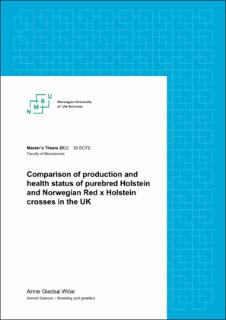Comparison of production and health status of purebred Holstein and Norwegian Red x Holstein crosses in the UK
Master thesis
Permanent lenke
https://hdl.handle.net/11250/3038205Utgivelsesdato
2022Metadata
Vis full innførselSamlinger
- Master’s theses (BioVit) [348]
Sammendrag
The goal of this thesis was to compare performance of purebred Holstein cows, Holstein crossed with Norwegian Red (NR) and various crossbreed combinations that included NR, by comparing their milk traits (kg. milk, fat yield, protein yield and somatic cell count), health (mastitis and lameness) and fertility (anoestrous and calving problems). A subgoal was to see how well commercial farm data from the UK could be used for statistical analyses. Data was received from 5 herds in the UK, with records from 2010 to 2021. The data was collected via Uniform, a farm management tool where the farmer inputs their farm data. Cows and heifers were put into different groups based on the breed of their sire, maternal grandsire, and maternal great grandsire. Breed codes consisted of six letters, for example NRFHFH (NR being Norwegian Red and FH being Holstein), with the two first being the breed of the sire, the two next the maternal grandsire, and the two last the maternal great grandsire. Not all animals had data for all three generations of sires, and those that had breed information from one generation or less were removed from the study. Breed groups considered were pure Holstein, NRxFH (NR sire and FH maternal grandsire), FHxNR (FH sire and NR maternal grandsire) and NRX (NR sire and non-FH maternal grandsire, or non-FH sire and NR maternal grandsire). Milk records were considered for 1 611 and 1 600 cows in total for all five herds for yield traits and somatic cell count (later used as somatic cell score (SCS)), respectively, while 2 510 individual cows and heifers were used when considering incidents of health and fertility problems. For milk related traits, analyses were only done for the breeds Holstein and NRxFH as there was little data for the other two breed groups. This gave a dataset for milk production with 2 976 observations and a dataset for SCS with 1 364 observations. All breed groups were considered for health and fertility problems. The study found that Holstein had significantly higher milk yield but lower protein yield than the NRxFH, and that there was no significant effect of breed on fat yield or somatic cell score. Trends of Holstein having more cases of mastitis, calving problems and anoestrous than the crossbreeds were found, as well as the percentage of lame NR-crosses being higher than that for Holstein, but lack of data made it impossible to achieve statistically reliable results for health and fertility. It is possible that incentives are needed to have farmers register more data and thus improve the chances of high statistic reliability.

